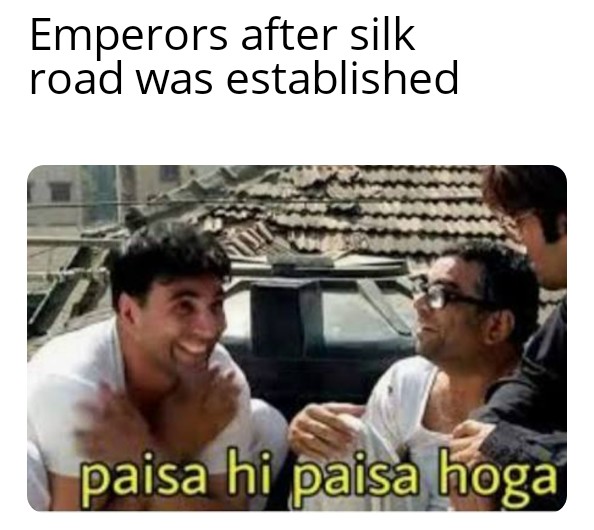ROADS AND MARGAS - TRADING IN ANCIENT INDIA
- The Inkonomics Blog
- Sep 19, 2020
- 4 min read
India is a rather large nation and accounts for about 30% of the Asian population. Being a peninsular region, its coastline has fostered trade and maritime activity. Trades of various kinds such as imports, exports, river-borne, seaborne and others were prevalent in the Indian subcontinent.

Initially, the BCE trade and industry were highly organized in India. Shrenis were formed, which were associations of traders, merchants, and artisans. Various shrenis existed for people engaged in different kinds of trade and economic activities. There also existed associations called “guilds” which were established to protect and safeguard the traders, craftsmen, etc. against unjust and oppressive rules and discriminations they bore victims to due to the kings and nawabs. The guilds also served as banks, its significance is mentioned in Kautilya’s Arthashastra.

The historic trade routes of the country covered most of the commercial cities and towns of various states/kingdoms such as ports of Barbaricum (present-day Karachi, Pakistan), Soungaora (Bangladesh), Barygaza, Muziris in Kochi, Kerala, Kaveripattanam and Arikamedu in Tamil Nadu, etc.
Despite India, due to the vast network of trading and industry, was also called: “Suvarna Bhoomi”. Most of the present-day state highways are on the path of the ancient trade routes. Most of the ghats that were being used to pass high mountains back then are still in use and have been upgraded to tar and concrete roads. The ancient pathways that were once filled with humble bullock carts are now being flooded with modern-day vehicles.
Mahamargas
The ancient trade routes can be majorly classified as Mahapatha, Vanikpatha, and Rajapatha. The early importance of Magadha may be explained by its strategic position in the Ganges (Ganga) River valley, enabling control over communication and trade. The central position of the Mahamarg was important as it was the longest route connecting south India. It had several branches bifurcating from important trade centres to the east and west. The main route starting from Pataliputra reached Bejawada crossing Rajagriha, Bhita Tripura, Nagpur and Vastagulm (Vashim in Vidarbha).
Dakshinapath - Rastriya Mahamarga
Pataliputra (Patna) was the capital of the Mauryan Empire, making this Mahamarg the longest route progressing to the south Asian nation. The main route ranging from Pataliputra reached Bejawada crossing Rajagriha, Bhita Tripura, and Nagpur to Vastagulm. The second vital route ranging from Pataliputra ran to Kanauj, turning south to Vidisa (Madhya Pradesh) and then, Maharastra. From there, it proceeded to the province through the province, visiting Tiruchirapalli in Kerala and Rameshwaram. The noted ports on Ratnakar (Arabian Sea) were in connection to the current road and commodities of export, both from north and central Asian nations reached the traditional ports. Another vital route from Ujjain entered Gujarat, the traditional business state with international retail store and harbours.
International commercial trade routes in ancient India
Inland routes were a significant factor of international trade in the ancient past. There were a few inland and sea routes such as-
Route from Kashgar linked through Kutch, then a trade colony and this route followed the Bactro-Tashkent to China highway and proceeded to Anhui via Lopnor.
Another route proceeded to China from Yarkand, a famous market place in medieval India.
The Uttarapatha route went through Vaisapur near Shahbazgarhi (present-day Pakistan) to Pushkalavati. From there, this route passed through Khyber Pass and then reached Bactria.
Bactria connected to Egypt through highways. It intensified India’s trade with Egypt as well.
China was connected to India by land routes. The Indo-China route passed through Assam, Upper Burma and Yunnan.
Essential goods traded were Cotton, Spices, Silk, Wood, Mica and Jute.
MEME CORNER
The Grand Trunk Road
The Grand Trunk Road is one of Asia’s oldest and largest road. It was a major trade route and was also used for invasions. The road was often dangerous due to heavy traffic. It was also known as Uttarapatha and linked the subcontinent with Central Asia. The presence of such a road network enabled pedestrian and military movements on a large scale, it also allowed the significant exchange of trade and material, and resulted in cultural and political developments in the sub-continent. It is still widely used. Initially, it was built by the emperor Chandragupta Maurya and later in the 16th century, it was rebuilt by Sher Shah Suri. In the 1830s, the road was renamed as the ‘Grand Trunk Road’. During the 3rd century BCE, it facilitated overland trade for India with West Asia and Bactriana. Later Ashoka built “Nimisdhyas” (rest houses) along the route. The route was also referred to as Sarak-e-Azam and BadshahiSarak in the16th century. However, it must be noted that individual segregated sections of the road were maintained during ancient and medieval times by the smaller kingdoms that emerged in northern India whenever a national imperial rule collapsed. Today, its part in Indian territory is divided into two Highways, National Highway 1 (links the west of Delhi to Atari, Punjab) and National Highway 2 (links the east of Delhi to Kolkata) that are maintained by the National Highways Authority of India. It is one of the ancient routes that has survived over a very long period of time. It has been fully functional since the ancient times till date. It is a unique road as it connects both land routes (Silk route) and sea routes. It was widely used for gaining political influence, pilgrimage activities and exchange of goods.






Comments